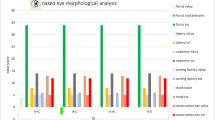Abstract
Stun guns are electric shocking devices that can be deployed as defensive or offensive weapons. The aim of this study was the identification of several types of trace evidence for corroborating deployment and providing clues to the weapon actually used. In a series of some 250 tests, the after-effects of firing a stun gun were studied under the differential influence of factors, such as time duration, distance from target, and bare skin vs clothing as target surface. Examination with scanning electron microscopy (SEM) and energy dispersive X-ray spectrometer (EDS) demonstrated the presence of metallic deposits corresponding to the electrodes of the device used. The observed differences in the number of these pellets were related to the length of deployment in seconds and to the distance of the weapon from the target surface. Longer duration of firing was consistently associated with a larger number of metallic deposits. Elemental composition of the latter provided clues to the type of device used and its current status in terms of wear and tear. Further trace evidence we examined included craters on the target surface and their pattern of dissemination on human skin, textiles, and leather. It is concluded that the use of carbon tabs for examination with SEM/EDS offers a practicable method for collecting trace material following stun gun deployment. Important groups of trace evidence do exist, and their collection and examination appear feasible.






Similar content being viewed by others
References
Altun G, Durmus-Altun G (2003) Confirmation of alleged falanga torture by bone scintigraphy—case report. Int J Legal Med 6:365–366
Anders S, Junge M, Schulz F, Püschel K (2003) Cutaneous current marks due to a stun gun injury. J Forensic Sci 48:640–642
Anders S, Tsokos M, Püschel K (2002) Nachweis der Stromwirkung und des Stromweges im Körper. Rechtsmedizin 1:1–9
Anslinger K, Selbertinger U, Bayer B, Rolf B, Eisenmenger W (2004) Ninhydrin treatment as a screening method for the suitability of swabs taken from contact stains for DNA analysis. Int J Legal Med 2:122–124
Banaschak S, Milbradt H, Humpert M, Roll P, Madea B (2001) Zum Nachweis der Anwendung von Elektroschockgeräten. Arch Kriminol 5/6:149–158
Bohnert M, Pollak S (2003) Heat-mediated changes to the hands and feet mimicking washerwoman’s skin. Int J Legal Med 2:102–105
Brinkmann K, Schäfer H (1982) Der Elektrounfall. Springer-Verlag, Berlin, Heidelberg, New York
Burdett-Smith P (1997) Stun gun injury. J Accid Emerg Med 14:402–404
Bux R, Andresen D, Rothschild MA (2002) Elektrowaffe advanced taser M26. Rechtsmedizin 12:207–213
Chapman B (1980) Glow discharge processes: sputtering and plasma etching. Wiley, New York
Denk W, Missliwetz J, Wieser I, Tauschitz C (1995) Elektroschockgeräte als Waffe. Arch Kriminol 196:78–86
Fish RM, Geddes LA (2001) Effects of stun guns and tasers. Lancet 358:687–688
Franz G (1990) Kalte Plasmen: Grundlagen, Erscheinungen, Anwendungen. Springer-Verlag, Berlin, Heidelberg, New York
Frechette A, Rimsza ME (1992) Stun gun injury: a new presentation of the battered child syndrome. Pediatrics 89:898–900
Giebe W, Biewald GA, Nachbar A, Scheler G (1995) Elektroschocker—eine tödliche Waffe?! Rechtsmedizin 5:138–141
Grubwieser P, Pavlic M, Günther M, Rabl W (2004) Airbag contact in traffic accidents: DNA detection to determine the driver identity. Int J Legal Med 1:9–13
Hieda Y, Tsujino Y, Xue Y, Takayama K, Fujihara J, Kimura K, Dekio S (2004) Skin analysis following dermal exposure to kerosene in rats: the effects of postmortem exposure and fire. Int J Legal Med 1:41–46
Ikeda N, Harada A, Suzuki T (1992) Homocidal manual strangulation and multiple stun-gun injuries. Am J Forensic Med Pathol 13(4):320–323
Kornblum RN, Reddy SK (1991) Effects of the taser in fatalities involving police confrontation. J Forensic Sci 36:434–448
Lerner RG, Trigg GL (1991). Encyclopedia of physics. VCH Verlagsgesellschaft, Weinheim
Miyamoto K (1989) Plasma physics for controlled fusion. MIT Press, Cambridge
O’Brien DJ (1991) Electronic weaponry—a question of safety. Ann Emerg Med 20:583–587
Robinson MN, Brooks CG, Renshaw GD (1990) Electric shock devices and their effects on the human body. Med Sci Law 30:285–300
Roeterdink EM, Dadour IR, Watling RJ (2004) Extraction of gunshot residues from the larvae of the forensically important blowfly calliphora dubia (Macquart) (Diptera: Calliphoridae). Int J Legal Med 2:63–70
Rothschild M, Kahl L, Schneider V (1996) Freiverkäufliche Elektroschockgeräte. Kriminalistik 96:428–430
Roy OZ, Podgorski AS (1989) Tests on a shocking device—the stun gun. Med Biol Eng Comput 27:445–448
Rutscher A, Deutsch H (1984) Plasmatechnik-Grundlagen und Anwendungen. Carl Hanser Verlag, Munich
Stacey WM (1981) Fusion plasma analysis. Wiley, New York
Sótony P, Darok M (1995) Die rasterelektronenmikroskopische elementanalyse in der rechtsmedizin. Rechtsmedizin 5:37–44
Szibor R, Michael M., Plate I et al. (2003) Identification of the minor component of a mixed stain by using mismatch primer-induced restriction sites in amplified mtDNA. Int J Legal Med 3:160–164
Turner Matthew S, Jumbelic MI (2003) Stun gun injuries in the abuse and death of a seven-month-old infant. J Forensic Sci 48:180–182
Author information
Authors and Affiliations
Corresponding author
Rights and permissions
About this article
Cite this article
Schmiederer, B., Du Chesne, A., Schmidt, P.F. et al. Specific traces in stun gun deployment. Int J Legal Med 119, 207–212 (2005). https://doi.org/10.1007/s00414-005-0532-1
Received:
Accepted:
Published:
Issue Date:
DOI: https://doi.org/10.1007/s00414-005-0532-1




